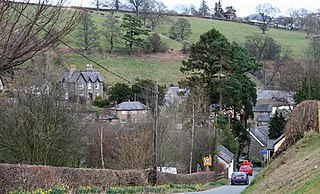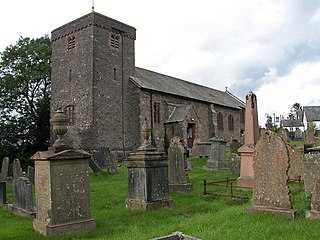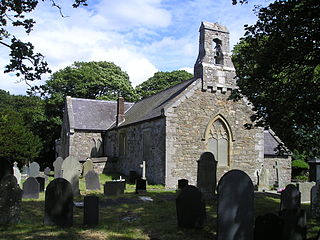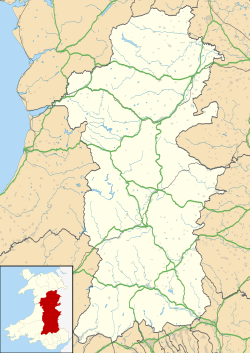
William Williams, Pantycelyn, also known as William Williams, Williams Pantycelyn, and Pantycelyn, is generally seen as Wales's premier hymnist. He is also rated among the great literary figures of Wales, as a writer of poetry and prose. In religion he was among the leaders of the 18th-century Welsh Methodist revival, along with the evangelists Howell Harris and Daniel Rowland.

Until 1974, Brecknockshire, also formerly known as the County of Brecknock, Breconshire, or the County of Brecon, was an administrative county in the south of Wales, later classed as one of the thirteen historic counties of Wales. Named after its county town of Brecon, the county was mountainous and primarily rural.

Llanrhaeadr-ym-Mochnant is a village, community and an ecclesiastical parish in the extreme north of Powys, Wales; about 9 miles west of Oswestry and 12 miles south of Llangollen, on the B4580. It lies near the foothills of the Berwyn mountains on the river Rhaeadr. At the top end of the valley is the Pistyll Rhaeadr waterfall, one of the Seven Wonders of Wales in the old rhyme. One mile north of the town is the hill Moel Hen-fache. The community includes the hamlet of Llanarmon Mynydd Mawr.

Llangammarch Wells or simply Llangammarch is a village in the community of Llangamarch in Powys, Wales, lying on the Afon Irfon, and in the historic county of Brecknockshire (Breconshire).

Llanwrtyd Wells is a market town and community in Powys, Wales, in the historic county of Brecknockshire (Breconshire) on the Afon Irfon. The town is on the A483 between Llandovery and Builth Wells and is located near the pass between the Tywi and Irfon valleys.

Meifod, formerly also written Meivod, is a small village, community and electoral ward 7 miles north-west of Welshpool in Montgomeryshire, Powys, Wales, on the A495 road and located in the valley of the River Vyrnwy. The River Banwy has a confluence with the Vyrnwy approximately two miles to the west of the village. The village itself had a population of 317. The community includes the village of Bwlch-y-cibau and the hamlet of Allt-y-Main.

Llanddewi Brefi is a village, parish and community of approximately 500 people in Ceredigion, Wales. The village is notable for the famous Synod of Brefi held here in the sixth century. A number of miraculous events are said to have occurred during the synod, most notably by Saint David Welsh: Dewi Sant, patron saint of Wales. Today, it is one of the largest parishes in Wales and lies 7 miles (11 km) north-east of Lampeter between Tregaron and Llanfair Clydogau.

Abergwesyn is a village in the Welsh county of Powys, in mid-Wales, at the start of the Abergwesyn valley and at the confluence of the Afon Irfon and the Afon Gwesyn. It is 52 miles (84 km) from Cardiff and 158 miles (254 km) from London.

The Diocese of Swansea and Brecon was established as a Diocese of the Church in Wales in 1923 with Brecon Priory as the cathedral. The area of the diocese had formerly been the Archdeaconry of Brecon within the Diocese of St Davids. The diocese has a border with each of the other five Welsh dioceses, as well as with the English Diocese of Hereford.

Llanrhos is a village in the community of Conwy, in Conwy County Borough, Wales. The village lies between the towns of Conwy and Llandudno. Llanrhos was a civil parish from 1894 until 1974. The area was formerly part of a larger parish called Eglwys Rhos or Eglwysrhos, being an old variant name for the same village. The ancient parish included Deganwy, the Craig-y-Don district of Llandudno, the Little Orme and Penrhyn Bay. The area was in the administrative county of Caernarfonshire prior to 1974.

Llanfyllin is a market town and community in Powys, Wales. The town population in 2021 was 1,586 and the town's name means church or parish (llan) of St Myllin. The community includes the settlements of Bodfach, Ty Crwyn, Abernaint and several farms.
Ruth Bidgood was a Welsh poet and local historian who wrote in English.
Llanfair-y-bryn is a community and Church in Wales parish in Carmarthenshire, Wales. Covering an area of some 95 km², it lies along and to the northwest and southeast of the A483 Swansea to Chester road immediately north of the town of Llandovery. The population of the community at the 2011 census was 624. The term also referred to a church located outside the parish.

Partrishow, also known as Patricio, Patrishow, or by its Welsh names Merthyr Isw and Llanisw, is a small village and historic parish in the county of Powys, close to its border with Monmouthshire. It is in the valley of the Grwyne Fawr, in the Black Mountains of South Wales, within the Brecon Beacons National Park.

Llanfechain is a village and community in Powys, Wales, on the B4393 road between Llanfyllin and Llansantffraid-ym-Mechain. Historically it belonged to Montgomeryshire. The River Cain runs through. The population of 465 at the 2011 Census was estimated at 476 in 2019.
Llan and its variants are a common element of Celtic placenames in the British Isles and Brittany, especially of Welsh toponymy. In Welsh the name of a local saint or a geomorphological description follows the Llan morpheme to form a single word: for example Llanfair is the parish or settlement around the church of St. Mair. Goidelic toponyms end in -lann.

Llanigon is a village and community in Powys, Wales on the edge of the Brecon Beacons National Park, north of the Black Mountains, Wales. The community population was 478. The nearest town is Hay-on-Wye, some 1.5 miles (2 km) to the east. It is in the historic county of Brecknockshire.
Pipton is a small settlement and former civil parish in Powys, Wales on the Afon Llynfi near its confluence with the River Wye. It was formerly in the county of Brecknockshire and is now part of the community of Bronllys. The nearest town is Hay-on-Wye some 5 miles (8.0 km) to the east.

Afon Irfon is a river in Powys, Wales. It flows from the upper slopes of Bryn Garw in the Cambrian Mountains, through the Abergwesyn Valley, past the Nant Irfon National Nature Reserve in the hills above the village of Abergwesyn, and through Llanwrtyd Wells to its confluence with the River Wye at Builth Wells. The source of the Irfon is in the so-called 'Desert of Wales'.

Whitewell is a dispersed rural settlement, and surrounding ecclesiastical parish, in the community of Bronington, in the east of Wrexham County Borough, Wales.

















